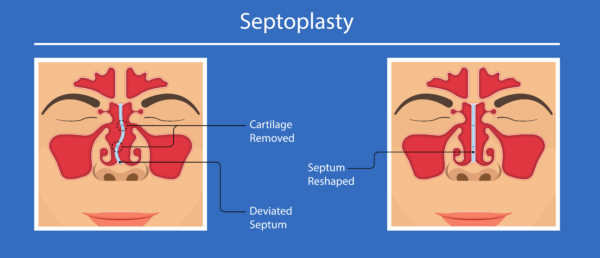
menu

Posted in Uncategorized | August 11, 2023

Do you have difficulty breathing? Are you wondering if there’s a solution that could help?
You may want to consider a septoplasty. A septoplasty is a procedure done to straighten a deviated septum.
The septum is the wall of cartilage and bone in the middle of your nose. It divides your nostrils into two separate ones: a right side and a left side.
When your septum is crooked or bent, it’s called a deviated septum. A deviated septum can cause breathing problems, sinus infections, and other bothersome symptoms that can lower your quality of life.
Keep reading to learn more about a deviated septum and septoplasty.

Ideally, the septum should be right in the middle of your nose, separating both nostrils equally. But for some people, the septum can be uneven or off-center.
As a result, one nasal passage becomes smaller in size than the other. Some people are born with a deviated septum, while others develop one after an injury or trauma.
You may need a septoplasty because of the following reasons:

Do you snore or have difficulty breathing through your nose? A deviated septum could be why you find it challenging to breathe.
Uneven airflow due to a severe deviation can make it harder to breathe freely through the smaller nostril. Still, the symptoms may occur on the other side of the bend in your nose.
Your ENT specialist at Specialty Care Institute may recommend a septoplasty if a curved septum interferes with your breathing. A septoplasty opens up your nasal passages and improves airflow.
Opening up your nasal passages to improve airflow can help you stop snoring and breathe better than you ever have.

The shape of your nasal cavity could be causing frequent sinus infections. When your septum is off-center, it may prevent your sinuses from draining mucus properly.
The excess mucus often provides the perfect breeding ground for bacteria, leading to frequent sinus infections. Some of the uncomfortable signs of a sinus infection include:
Sinusitis or a sinus infection typically goes away after a few days with hydration, rest, vitamin C, and painkillers. But if your symptoms only worsen and persist for 12 weeks or more, you may have chronic sinusitis.
A septoplasty to straighten a curved septum can open your nasal passages for improved sinus drainage. Better drainage will mean fewer sinus infections.

While many people only experience an occasional nosebleed, others have nosebleeds frequently. One of the most common causes of recurring nosebleeds is the drying out of your nasal membranes, which can result from a deviated septum.
A curved septum creates turbulence as air moves through your nostrils. The turbulence leaves your nasal passage and membranes dry.
When dry, nasal membranes crack, it exposes fragile blood vessels. Your nose is filled with delicate blood vessels protected by thin nasal membranes.
Cracked nasal membranes can cause the blood vessels to break and bleed. Also, a crust can form when your nasal passages become too dry.
The crust may bleed when irritated by blowing your nose. A septoplasty offers a long-term solution for regular nosebleeds.
During the procedure, your surgeon can realign or remove the part of the septum that deviates into your airway. The procedure will improve your nose’s ability to function and drastically reduce the frequency of your nosebleeds.

A crooked septum can make it more challenging to breathe through your nose, leading to sleeping problems. Imagine trying to sleep with a stuffy, congested nose.
In severe cases, you can develop sleep apnea. Sleep apnea is a serious sleep disorder that results in your breathing stopping for several seconds throughout the night.
Sleep apnea can lead to health complications without timely treatment. Some of the complications linked to sleep apnea include:
A septoplasty can reposition the septum to the middle of your nose. After the procedure, you’ll be able to breathe more easily and get a better night’s sleep.
You can have a septoplasty performed as a closed or open procedure. In an open procedure, your surgeon creates an incision across your columella.
The columella is the tissue in front of the septum. It bridges the space between your nostrils.
During a closed procedure, your surgeon will only use interior incisions. You’ll receive local or general anesthesia during a septoplasty. Your surgeon will then create an incision in your columella or inside your nostrils.
Your surgeon will then separate the mucosa lining from the underlying bone and cartilage through the incision. The mucosa lining is a soft layer of tissue covering your septum.
Next, they will straighten and reposition any uneven bone and cartilage in your septum. If there are any obstructions, such as extra pieces of bone or cartilage, your surgeon will cut or trim them.
Once done, the lining is put back in place. Finally, your surgeon may use soft splints to hold your septum in position before closing the incision with absorbable stitches. Your nose will also be packed with cotton to help with any bleeding.
A septoplasty is often done on an outpatient basis and lasts anywhere from 60 to 90 minutes. Most patients can return home about two to three hours after the procedure.
A septoplasty permanently corrects a deviated septum, allowing equal airflow through your nasal passages.
You’ll feel drowsy for several hours following your procedure. You might be nauseous because of the anesthesia.
Let your nurse know about any after-effects. You can receive medications to aid with the symptoms.
You should be able to return home after your anesthesia wears off. There will be some pain and swelling. As you recover from a septoplasty, these will go down slowly during the first few days.
It’s not unusual to bleed for the first few days. Also, expect some nasal discharge and congestion.
These symptoms should typically improve in about two weeks. Because of the packing in both nostrils, you’ll have to breathe through your mouth for some time.
Your ENT specialist at Specialty Care Institute will let you know when you can remove the packing. If you have splints in your septum, you’ll return in 7 days to have them removed.
You can resume most of your normal activities within 7 to 10 days.
As you recover, wait at least three days before blowing your nose to ensure you don’t harm your nose. You’ll want to avoid completing any physical activity, including exercise, for a few weeks to prevent bleeding.
Wear button-up clothes so you don’t have to pull them over your head. At night when you’re sleeping or resting, keep your head raised while sleeping and resting to minimize swelling and relieve congestion.
Above all else, follow all instructions from your ENT specialist to ensure a safe recovery.

You might want to consider a septoplasty if you have breathing difficulties, sleeping problems, or other signs of a deviated septum. A septoplasty performed at Specialty Care Institute can alleviate your symptoms and help you live your best life.
Do you think you might need a septoplasty? Schedule an appointment at Specialty Care Institute in Arlington Heights, Barrington, Elgin, or Hoffman Estates, IL, to learn more!